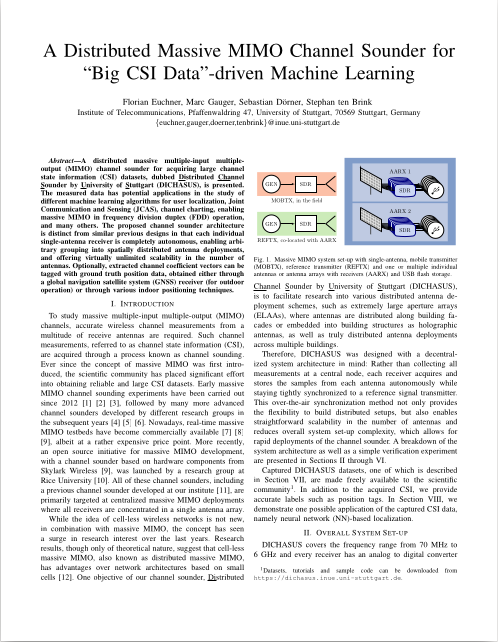
DICHASUS Massive MIMO CSI Dataset Collection
The DICHASUS (DIstributed CHAnnel Sounder by University of Stuttgart) dataset collection contains channel state information (CSI) datasets for line of sight, non-line of sight, indoor, outdoor, colocated and distributed antenna configurations, complete with "ground truth" positioning labels.
OTA Synchronization
DICHASUS uses a reference synchronization signal and an over-the-air synchronization protocol to precisely align all receivers in frequency, time and phase. Thanks to this flexible system architecture, our datasets contain phase-coherent channel measurements, even if individual receivers are distributed across a large area.
Repeatable Results
Measured channels should be a function of the physical environment and only of the physical environment. When the transmitter returns to the same position and the physical environment remains unchanged, the measured channel state information must be identical or similar, even if many minutes, hours, days have passed. This requires highly accurate clock synchronization.
Accurate "Ground Truth"
Machine learning algorithms can only be as good as the underlying "ground truth" labels such as position tags and timestamps. Therefore, we strive to provide the most precise ground truth data possible. We use differential GNSS, tachymeters, LiDAR sensors and other indoor positioning technologies to gather position metadata with centimeter-level or even millimeter-level accuracies.
How to Cite
-
Please cite our paper if you use datasets from this site for your own research.
This paper explains in a general sense how data was collected and postprocessed:
@inproceedings{dichasus2021, author = {Florian Euchner and Marc Gauger and Sebastian D\"orner and Stephan ten Brink}, title = {{A Distributed Massive MIMO Channel Sounder for "Big CSI Data"-driven Machine Learning}}, booktitle = {WSA 2021; 25th International ITG Workshop on Smart Antennas}, year = {2021} } - Each dataset is unambiguously identified by its DOI. Please cite this identifier to refer to the specific datasets you analyzed in your own research. Refer to each dataset's page for more information.




